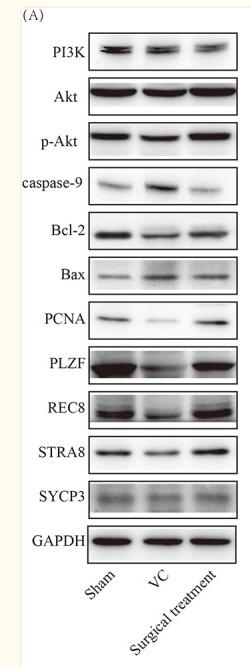ZBTB16 Antibody - #DF2611
| Product: | ZBTB16 Antibody |
| Catalog: | DF2611 |
| Description: | Rabbit polyclonal antibody to ZBTB16 |
| Application: | WB |
| Cited expt.: | WB |
| Reactivity: | Human, Mouse, Rat |
| Prediction: | Pig, Bovine, Rabbit, Dog, Chicken |
| Mol.Wt.: | 85 kDa; 74kD(Calculated). |
| Uniprot: | Q05516 |
| RRID: | AB_2839817 |
Related Downloads
Protocols
Product Info
*The optimal dilutions should be determined by the end user.
*Tips:
WB: For western blot detection of denatured protein samples. IHC: For immunohistochemical detection of paraffin sections (IHC-p) or frozen sections (IHC-f) of tissue samples. IF/ICC: For immunofluorescence detection of cell samples. ELISA(peptide): For ELISA detection of antigenic peptide.
Cite Format: Affinity Biosciences Cat# DF2611, RRID:AB_2839817.
Fold/Unfold
AI467657; lu; PLZF; Promyelocytic leukemia zinc finger protein; ZBT16_HUMAN; ZBTB16; Zfp145; Zinc finger and BTB domain containing 16; zinc finger and BTB domain containing protein 16; Zinc finger and BTB domain-containing protein 16; Zinc finger protein 145 (Kruppel like expressed in promyelocytic leukemia); Zinc finger protein 145; Zinc finger protein PLZF; Znf145;
Immunogens
A synthesized peptide derived from human ZBTB16, corresponding to a region within the internal amino acids.
Within the hematopoietic system, PLZF is expressed in bone marrow, early myeloid cell lines and peripheral blood mononuclear cells. Also expressed in the ovary, and at lower levels, in the kidney and lung.
- Q05516 ZBT16_HUMAN:
- Protein BLAST With
- NCBI/
- ExPASy/
- Uniprot
MDLTKMGMIQLQNPSHPTGLLCKANQMRLAGTLCDVVIMVDSQEFHAHRTVLACTSKMFEILFHRNSQHYTLDFLSPKTFQQILEYAYTATLQAKAEDLDDLLYAAEILEIEYLEEQCLKMLETIQASDDNDTEATMADGGAEEEEDRKARYLKNIFISKHSSEESGYASVAGQSLPGPMVDQSPSVSTSFGLSAMSPTKAAVDSLMTIGQSLLQGTLQPPAGPEEPTLAGGGRHPGVAEVKTEMMQVDEVPSQDSPGAAESSISGGMGDKVEERGKEGPGTPTRSSVITSARELHYGREESAEQVPPPAEAGQAPTGRPEHPAPPPEKHLGIYSVLPNHKADAVLSMPSSVTSGLHVQPALAVSMDFSTYGGLLPQGFIQRELFSKLGELAVGMKSESRTIGEQCSVCGVELPDNEAVEQHRKLHSGMKTYGCELCGKRFLDSLRLRMHLLAHSAGAKAFVCDQCGAQFSKEDALETHRQTHTGTDMAVFCLLCGKRFQAQSALQQHMEVHAGVRSYICSECNRTFPSHTALKRHLRSHTGDHPYECEFCGSCFRDESTLKSHKRIHTGEKPYECNGCGKKFSLKHQLETHYRVHTGEKPFECKLCHQRSRDYSAMIKHLRTHNGASPYQCTICTEYCPSLSSMQKHMKGHKPEEIPPDWRIEKTYLYLCYV
Predictions
Score>80(red) has high confidence and is suggested to be used for WB detection. *The prediction model is mainly based on the alignment of immunogen sequences, the results are for reference only, not as the basis of quality assurance.
High(score>80) Medium(80>score>50) Low(score<50) No confidence
Research Backgrounds
Acts as a transcriptional repressor. May play a role in myeloid maturation and in the development and/or maintenance of other differentiated tissues. Probable substrate-recognition component of an E3 ubiquitin-protein ligase complex which mediates the ubiquitination and subsequent proteasomal degradation of target proteins.
Nucleus. Nucleus>Nuclear body.
Within the hematopoietic system, PLZF is expressed in bone marrow, early myeloid cell lines and peripheral blood mononuclear cells. Also expressed in the ovary, and at lower levels, in the kidney and lung.
Belongs to the krueppel C2H2-type zinc-finger protein family.
Research Fields
· Human Diseases > Cancers: Overview > Pathways in cancer. (View pathway)
· Human Diseases > Cancers: Overview > Transcriptional misregulation in cancer.
· Human Diseases > Cancers: Specific types > Acute myeloid leukemia. (View pathway)
References
Application: WB Species: Rat Sample: testicular tissues
Application: WB Species: rat Sample: Testicular
Restrictive clause
Affinity Biosciences tests all products strictly. Citations are provided as a resource for additional applications that have not been validated by Affinity Biosciences. Please choose the appropriate format for each application and consult Materials and Methods sections for additional details about the use of any product in these publications.
For Research Use Only.
Not for use in diagnostic or therapeutic procedures. Not for resale. Not for distribution without written consent. Affinity Biosciences will not be held responsible for patent infringement or other violations that may occur with the use of our products. Affinity Biosciences, Affinity Biosciences Logo and all other trademarks are the property of Affinity Biosciences LTD.

